Beef Ularthiyathu, also known as Kerala Beef Fry, is a hallmark dish that embodies the essence and vibrancy of Kerala’s culinary diversity. Esteemed for its rich spices and aromatic flavors, this dish represents the cultural and historical tapestry of Kerala, a state on the southwestern coast of India renowned for its love for spices.
The preparation of Beef Ularthiyathu involves marinating beef chunks with a blend of local spices, such as turmeric, coriander, black pepper, garam masala, and curry leaves, which contribute to its distinctive and robust flavor profile. The marinated beef is then slow-cooked to perfection, ensuring that it absorbs the spices’ intricate flavors. As the cooking progresses, coconut slices or small pieces are added, which caramelize and infuse the dish with a subtle sweetness, balancing the heat from the spices.
An integral step in making Ularthiyathu is the ‘ulli varuthathinga,’ where shallots are browned, and spices are roasted to a crisp texture, lending a crunchy contrast to the tender beef. This technique enhances the dish’s complexity, adding depth to its rich layers of flavor. A drizzle of coconut oil at the end of the cooking process elevates the fry with its signature aroma, tying all elements together harmoniously.
Beef Ularthiyathu recipe
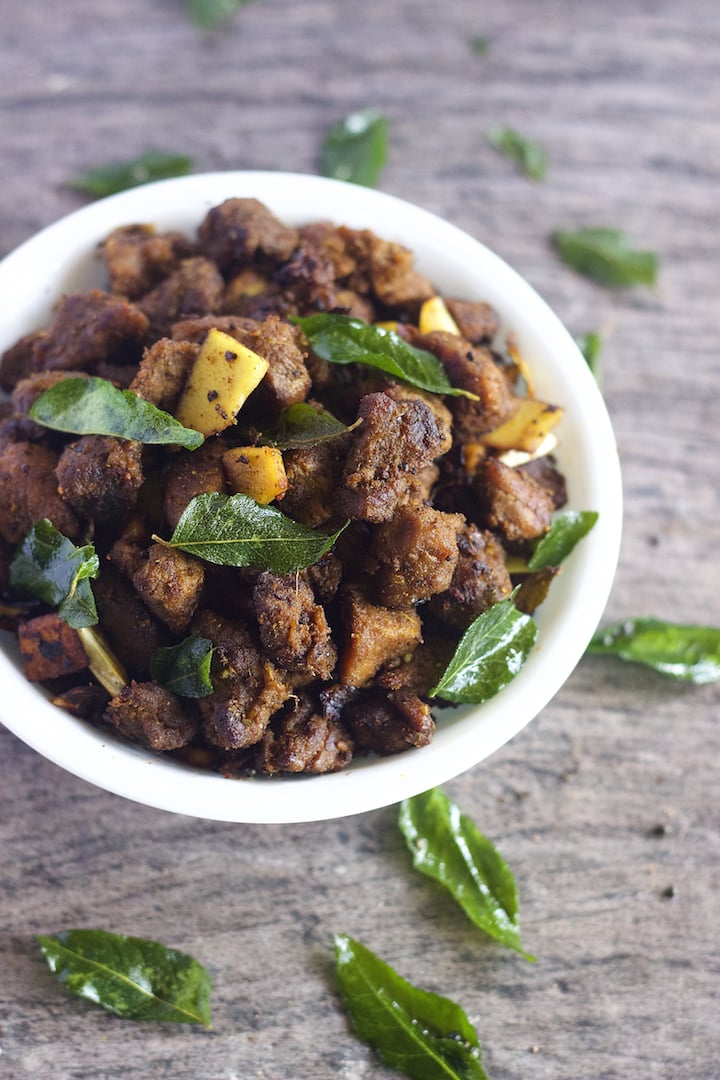
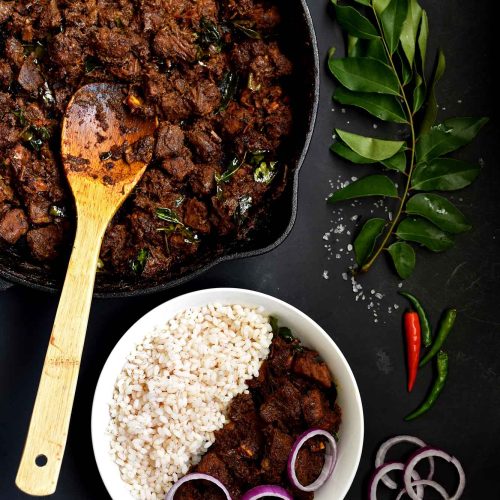
Beef Ularthiyathu
Equipment
- 1 electric pressure cooker
- 1 large skillet
Ingredients
- 2 pounds beef chuck or round roast or steak, cut into 1 inch cubes
- 1 teaspoon salt
- 1/2 teaspoon freshly ground black pepper
- 1/2 teaspoon ground turmeric
- 1/2 cup water
- 2 tablespoons plus 1 teaspoon coconut oil divided
- 2 curry leaf sprigs divided
- 2 onions sliced
- 3 green chiles minced
- 2 garlic cloves minced
- 1 1/2-inch piece fresh ginger, peeled and minced
- 1 teaspoon red chile powder
- 1 teaspoon ground coriander
- 1 teaspoon garam masala
- 2 tablespoons dried coconut flakes or slices
Instructions
- In an electric pressure cooker, such as the Instant Pot®, or stovetop pressure cooker or pressure pan, combine the beef, salt, pepper, and turmeric. Mix well and add the water.
- For an electric pressure cooker, lock the lid into place and make sure the valve is in the Sealed position. Select Pressure Cook or Manual and set the time to 15 minutes on High Pressure. Once the cooking is complete, let the pressure release naturally for 10 minutes, then quick release any remaining pressure. For a stovetop pressure cooker, place it over medium heat and place the lid on. Ensure the sealing ring is on and place the weight on. Pressure cook until the cooker “whistles” 2 times. When the cooking is done, let the pressure release naturally for 10 minutes, then quick release any remaining pressure.
- While the beef cooks, in a large skillet over medium-high heat, heat 2 tablespoons of coconut oil.
- Add half the curry leaves, the onions, and green chiles to the skillet and mix well. Cook for 5 to 6 minutes, stirring frequently, until the onions are softened.
- Add the garlic and ginger and cook for 1 minute, stirring constantly.
- Stir in the chile powder, coriander, and garam masala. Reduce the heat to low.
- When the meat is ready, carefully unlock and remove the lid of the pressure cooker. Transfer the meat and any juices in the pot to the skillet. Stir well and bring the mixture to a simmer. Cook the meat until any liquid dries out, about 5 minutes, stirring occasionally to prevent scorching.
- Meanwhile, in a small skillet over medium heat, heat the remaining 1 teaspoon of coconut oil.
- Add the dried coconut and cook for about 3 minutes, stirring frequently, until browned.
- Add the remaining curry leaves and cook, stirring well, until the leaves are browned. Remove from the heat and set aside.
- Once the liquid has boiled out of the skillet with the beef, continue cooking for a few minutes more, stirring constantly, until the meat is completely dried out. Add the browned curry leaves and coconut and stir to combine.
Notes
Cooking Tips about Beef Ularthiyathu
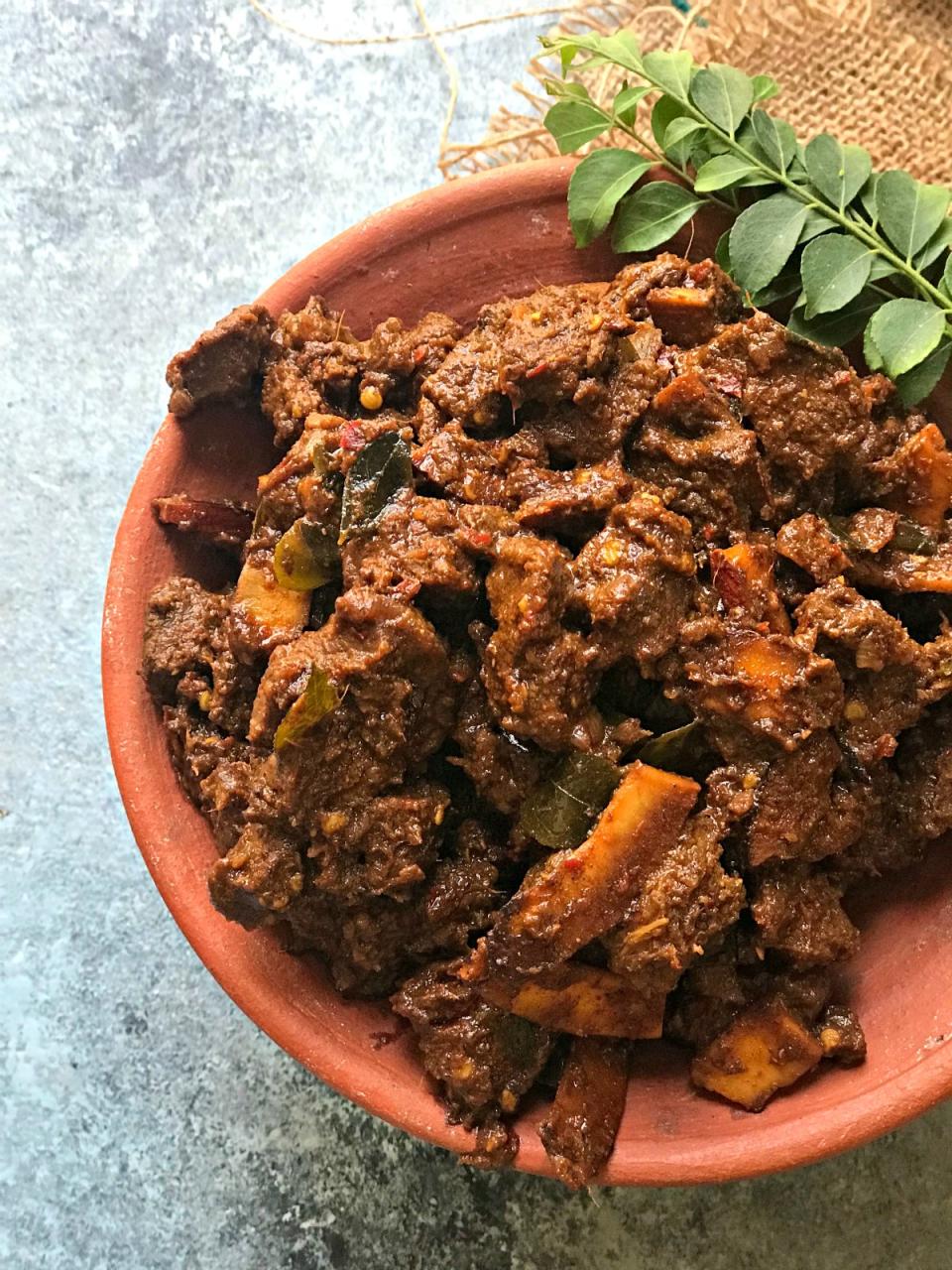
- Select the Right Cut of Beef: For Beef Ularthiyathu, opt for cuts of beef that are slightly fatty as they tend to be more flavorful. Chuck or brisket cuts work well because they become tender and juicy upon slow cooking.
- Marinate the Beef: Enhance the flavor of the beef by marinating it with spices such as turmeric powder, chili powder, coriander powder, black pepper, garam masala, crushed garlic, and salt. Letting the meat marinate for at least a couple of hours, or even overnight in the refrigerator, helps the flavors penetrate deeply.
- Roasting Spices: Kerala’s cuisine is known for its aromatic spices. To bring out their full flavor in your Ularthiyathu, dry roast spices like fennel seeds, cloves, and cinnamon before grinding them into a fine powder. This roasted spice mix can then be added to the beef during cooking.
- Coconut Oil and Curry Leaves: The use of coconut oil and curry leaves is quintessential in this dish. Coconut oil adds a distinct flavor that is characteristic of Kerala dishes, while curry leaves add an unmistakable aroma when fried in hot oil before adding the beef.
- Slow Cooking: Beef Ularthiyathu benefits greatly from slow cooking on a low flame. This method allows the beef to cook evenly and absorb all the spices, tenderizing the meat and concentrating the flavors.
- Use of Coconut Slices: Adding thinly sliced or chopped pieces of coconut provides a delightful contrast in texture and a subtle sweetness that balances the robust flavors of the spices. Fry the coconut pieces until golden brown before mixing them with the beef.
- Adjusting Heat: The dish traditionally has a fiery element, thanks to the use of black pepper and chili. However, you can adjust the level of heat according to your spice tolerance. Remember, the spice should enhance the flavors, not overpower them.
- Finishing Touches: Once the beef is cooked tender and the spices have melded together beautifully, finish the dish by increasing the flame and stirring continuously to reduce any excess moisture. This process gives the beef a perfect coating of the masala, making it dry and flavorful.
- Resting Time: Allow the dish to rest for a little while after cooking. This resting period lets the flavors settle and meld together even further.
- Serving Suggestions: Serve Beef Ularthiyathu with rice, Malabar parotta (layered flatbread), appam (rice and coconut pancake), or even a simple dose of steamed rice. The rich flavors of the dish complement these sides very well, providing a complete meal experience.
Serving suggestions about Beef Ularthiyathu
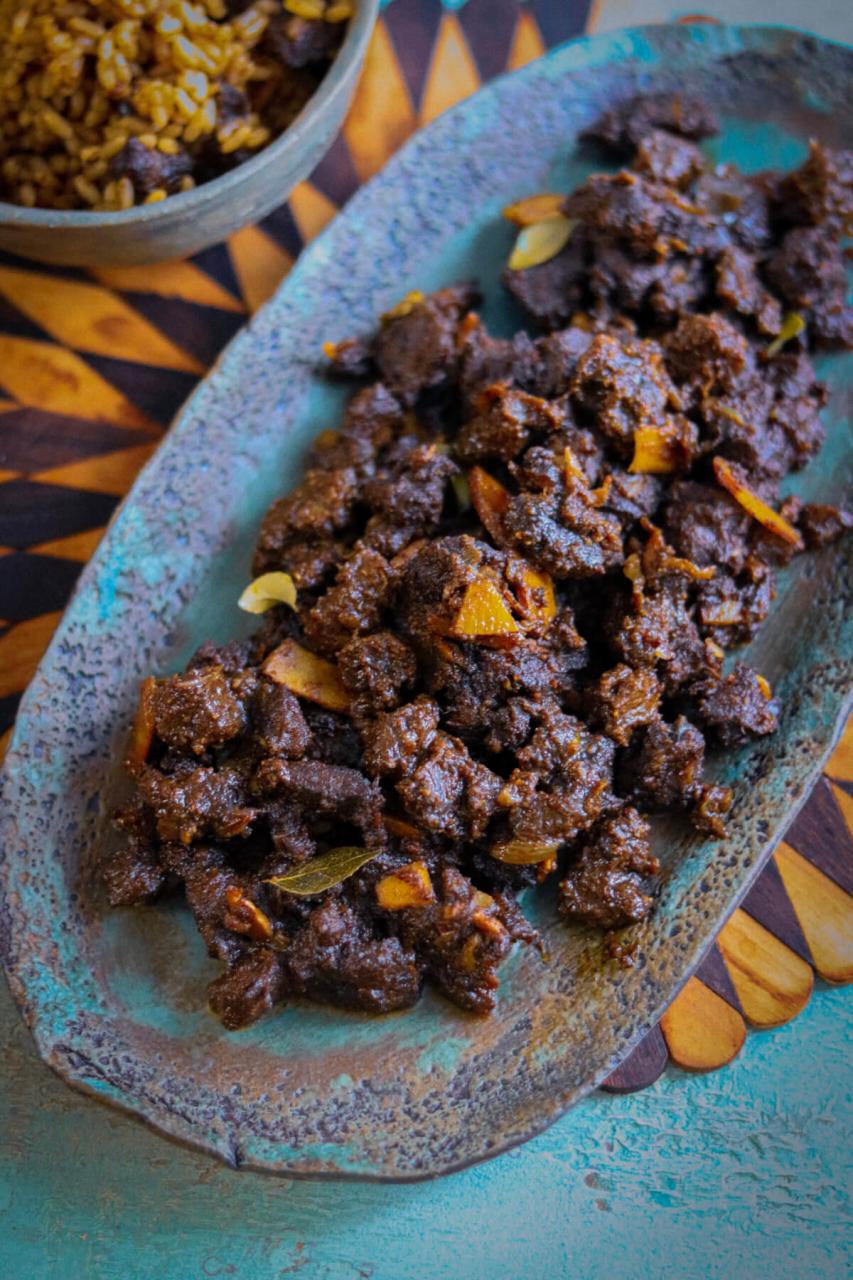
- With Rice Varieties: Savored simply with steamed rice, the robust flavors of Beef Ularthiyathu provide a deeply satisfying meal experience. For a more elaborate dining occasion, pairing it with ghee rice or coconut rice adds an extra layer of flavor, creating a luxurious taste combination.
- Kerala Parotta Companion: The flaky, layered texture of Kerala Parottas makes them an ideal side for Beef Ularthiyathu. Tearing off a piece of parotta and scooping up the richly spiced beef offers a delightful contrast in textures and flavors.
- In a Malabar Porotta Wrap: For a fusion twist, use Malabar parottas to create wraps filled with Beef Ularthiyathu. Add slices of onions, a few drops of lemon juice, and wrap it up for a convenient and tasty meal on-the-go.
- As a Taco Filling: Think outside the box and use Beef Ularthiyathu as a filling for tacos. Top with fresh cilantro, diced tomatoes, and a squeeze of lime for an Indo-Mexican fusion delight.
- With Dosa: Pairing the meaty, spicy Beef Ularthiyathu with the crispy, mild-flavored dosa creates an unexpected yet harmonious combination. This unconventional pairing will appeal to those looking to explore beyond traditional boundaries.
- Kanji (Rice Porridge) Side Dish: In Kerala, a common comforting meal is Kanji (rice porridge), accompanied by side dishes. Beef Ularthiyathu serves as a flavorful and hearty companion to the blandness of kanji, enhancing the overall taste.
- Sandwich or Burger Filling: Elevate your sandwich or burger by using Beef Ularthiyathu as the main protein. Its rich flavor profile adds an exciting kick to the standard fare.
- As Part of a Sadya During Non-Vegetarian Feasts: While a traditional Kerala Sadya is strictly vegetarian, during non-vegetarian feasts, Beef Ularthiyathu can take center stage, providing a meaty counterpart to the vegetable dishes.
- Salad Topping: For a lighter option, slice the beef into thin strips and use it to top off a fresh green salad. The spiciness of the beef contrasts beautifully with the crisp coolness of the salad.
Top 5 FAQs about Beef Ularthiyathu
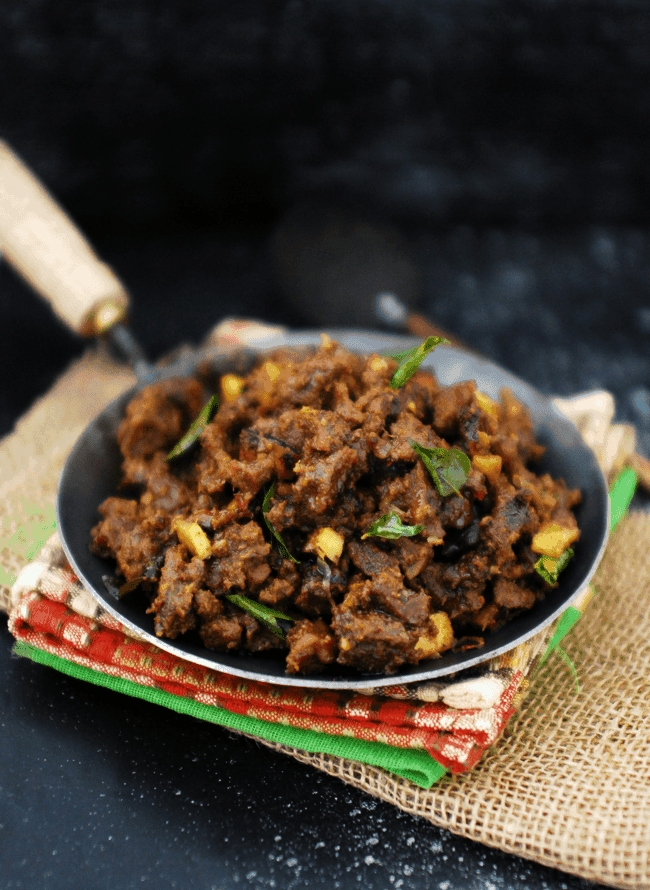
- What is Beef Ularthiyathu? Beef Ularthiyathu, also known as Kerala Beef Fry, is a celebrated dish from Kerala, India, known for its rich spices and aromatic flavors. This dish consists of beef chunks marinated and slow-cooked with traditional spices like turmeric, coriander, black pepper, garam masala, and curry leaves, complemented by coconut slices that add a subtle sweetness.
- Why is Beef Ularthiyathu considered special in Kerala’s cuisine? Beef Ularthiyathu holds a special place in Kerala’s culinary tradition due to its intricate blend of local spices and cooking techniques that showcase the region’s historical love for spices. The method of slow cooking the beef until it’s tender, along with the final touch of coconut oil, represents Kerala’s rich cultural and historical tapestry, making it a festive and everyday favorite.
- Can Beef Ularthiyathu be made with other meats? Traditionally, Beef Ularthiyathu is made with beef because of the meat’s ability to absorb the complex flavors of the spices used in the recipe. However, you could experiment with other meats like mutton or chicken, keeping in mind the cooking times may vary based on the meat’s tenderness.
- How is Beef Ularthiyathu usually served? Beef Ularthiyathu is versatile and can be enjoyed with various accompaniments. It is commonly served as a main course alongside rice, Malabar parottas (a type of layered flatbread), or appam (rice and coconut pancakes). Its robust flavors make it suitable for both daily meals and special occasions.
- Are there any key tips for making authentic Beef Ularthiyathu? For an authentic taste, selecting the right cut of slightly fatty beef is crucial. Marinating the beef for several hours or overnight intensifies the flavors. Slow-cooking and the practice of “ulli varuthathinga,” where shallots and spices are browned to perfection, are essential steps. Using coconut oil and adding caramelized coconut pieces or small slices towards the end of cooking not only enhances the flavor but also adds texture to the dish.
Beef Ularthiyathu stands as a proud testament to the rich culinary landscape of Kerala, India. This dish, celebrated for its profound flavors and cultural significance, encapsulates the essence of Kerala’s love affair with spices and its expertise in creating dishes that offer a kaleidoscope of tastes. By carefully marinating beef in a symphony of spices and slow-cooking it to perfection, Beef Ularthiyathu achieves a harmonious balance between robustness and subtlety – a characteristic hallmark of Kerala’s culinary tradition.

Leave a Reply